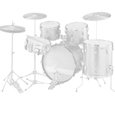Recent trends in repertoire selection include increased incorporation of popular, jazz, movie soundtrack, and Broadway tunes into programming. Ensemble directors who choose these pieces must be prepared to coach young musicians in fundamental technical and musical aspects of each style on drumset. Many composers and arrangers provide rather sparse drumset parts, so drummers are likely to need help interpreting score indications. A drumset part might just be skeletal, with one bar of pattern written at the very beginning or a note that says “boogie-woogie shuffle” or “swing jazz,” which leaves very little with which to work. If directors have a concept of a basic beat in a style, they can help students make sense of those terms. Well-prepared directors can also arrange or notate appropriate drumset parts for unpublished pieces.
When first seated at the drumset, even the best student percussionists may struggle in several areas, including coordination of three or four limbs, dynamic balance of multiple parts, complex notation, and mastery of stylistic nuance. Sequential development of drumset skills can bear efficient and thorough results over time, and wise directors should groom percussionists to play drumset well before it is needed. Here is a summary of basic patterns.
The Core Pattern
Many common styles are based on a core pattern, which is useful in rock, pop, and ballad tunes and is intended to provide a point of departure for all style variations that follow. Students can master drumset techniques by learning the core pattern first and then applying them to all subsequent patterns.
.jpg)
.jpg)
This pattern consists of a simple pattern of bass and snare drum notes, against the consistent flow of eighth notes on the hi-hat. Directors can proactively coach students in coordinating this pattern. Of primary importance is starting with a slow tempo and maintaining that tempo throughout the initial stages of development.
If students cannot coordinate all three limbs at first, they should try two at a time. The best approach is to start with the hands, because most percussionists will have used their hands a lot more than their feet. Have students play the hand parts together first; they are likely to be able to do this quickly. The difficulty is coordinating each hand with the foot separately, so try hi-hat and bass, snare and bass. When all possible limb pairings are easy for students, they should then approach three-limb coordination again.
Students should focus on the hi-hat hand for tempo maintenance, and attempt to align the snare drum and bass drum limbs precisely to it. If a particular vertical slice of the pattern is troublesome, isolate those notes, slow down the tempo, and repeat them until stable, before incorporating them back into the full pattern.
Latin
The influence of Latin styles on music in schools is increasing rapidly. Drummers with even the most basic command of appropriate patterns can bring great energy to Latin-style instrumental arrangements. The shift from the core pattern to the Latin variation is extremely slight. The hi-hat remains the same throughout. The snare drum on beat two is played as a cross-stick or rim knock, and the eighth notes on beat four are played on the tom-tom. This pair of notes can be played on one drum, as shown, or split between any two. Note that the accent has been shifted to the upbeat to provide extra flavor.
.jpg)
Shuffle
Young drummers can use a shuffle pattern for a variety of styles, including blues, jazz, rock, country, and show tunes. The core pattern and shuffle pattern are almost identical in notation, except for the addition of bass drum on beats two and four; the primary difference between the two is that all eighth notes in shuffle are swung. Students struggling with this pattern should return to the core pattern first, reinforcing the original physical movements and resulting sounds.
.jpg)
.jpg)
Modeling is a simple and direct way to help students grasp the rhythm and style of swung eighth notes. Students should practice swinging notes on a single surface, such as snare drum. In coordinating the limbs to execute swung rhythmic pairs in the shuffle, the same tactics apply as for the core pattern: start slow, coordinate two limbs at a time in every combination, combine all limbs when ready, and maintain focus on the hi-hat hand for tempo consistency, because it plays all possible notes.
Swing
Swing is a common but vague style indication in many compositions and arrangements for large and small ensembles. There is a close relationship between the basic shuffle and swing patterns. The hi-hat hand has simply switched to the ride cymbal, and the left foot has been added on the hi-hat on beats two and four. The ands of beats one and three have been removed, placing natural emphasis on the quarter-note pulse; developing and monitoring this pulse is crucial to a strong swing feel.
.jpg)
.jpg)
On the ride cymbal, which should be hit about a third of the way from the edge to the bell, students can practice alternating between just quarter notes and the pattern as shown, gradually reinforcing the integrity of the underlying pulse in the full pattern. The ride cymbal part in this pattern can also be played on the hi-hat instead, creating an open hi-hat sound on beats one and three.
Balance is especially important in swing style. The bass drum in a swing beat should be light, although beginning drumset players have clunky feet and tend to overplay the bass drum. The same is true for students who learn to play drumset on their own; many times it will be with a heavy rock beat, which naturally has a strong bass drum part.
Two-Beat
The two-beat style is quite common in Country, American folk music, and Broadway show tunes. Two-beat patterns are usually quite simple technically, but can be varied greatly for a wide range of musical nuance; because of the relative simplicity of the pattern, notes can be added, deleted, or emphasized according to the specific nature of the music. In the example, an extra snare drum note is added at the end of the second measure to provide direction to the line. Other embellishments of this pattern could include occasional hi-hat splashes with the foot, added hi-hat notes for emphasis, or quick doubles on the snare drum for rhythmic interest. The pattern in Figure 5 appears to be furthest afield from any of the other patterns above, but is actually a synthesis of elements from all of them.
.jpg)
.jpg)
Arranging
When writing drumset parts, less is more. Avoid giving students too much ink to look at or too many sounds to play. With these patterns from the article, there is still some responsibility on the part of the director to bring out specific notes as needed. A tune might be best helped by a strong hit on the and of three or by leaving out a snare hit, for example.
Look at the score to find the overall rhythmic spectrum of the ensemble at any given point; from there it should be easy to determine how the drumset can support the music without dominating or overplaying another part. Think of scoring for drumset as finding the instruments filling the function of a rhythm section in a group that may not have an actual rhythm section. Paying attention to the bass line will be extremely important, and if there are voices such as horns or saxophone parts playing chords that might be reminiscent of a keyboard part, then match those.
The gradual progression from the core pattern through each of the four variations presented above demonstrates how slight changes in instrumentation, rhythm, and articulation can create a variety of styles at the drumset. Students can practice these patterns sequentially as presented here, and then by mixing the order of styles. Percussionists who master these examples will have developed the basic versatility needed to play in a wide variety of styles, benefitting themselves, their ensembles, directors, and instrumental programs.






